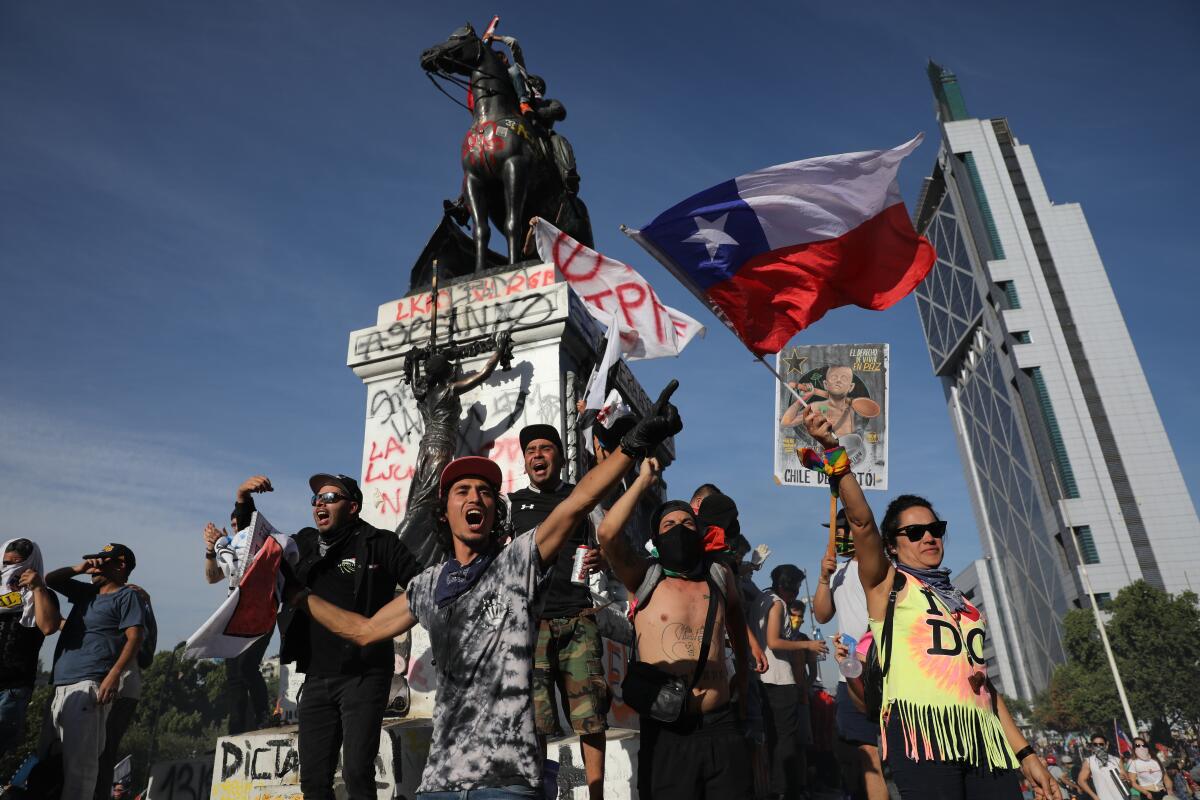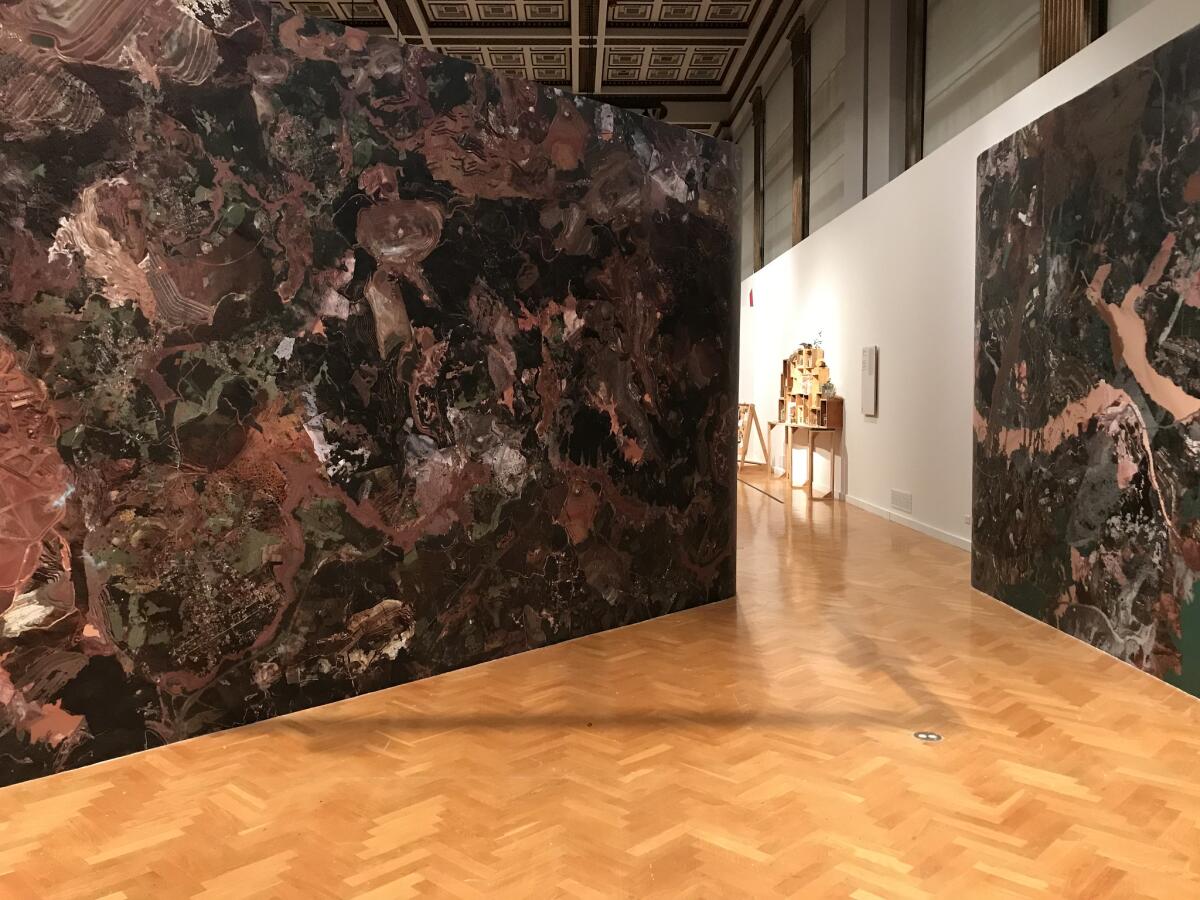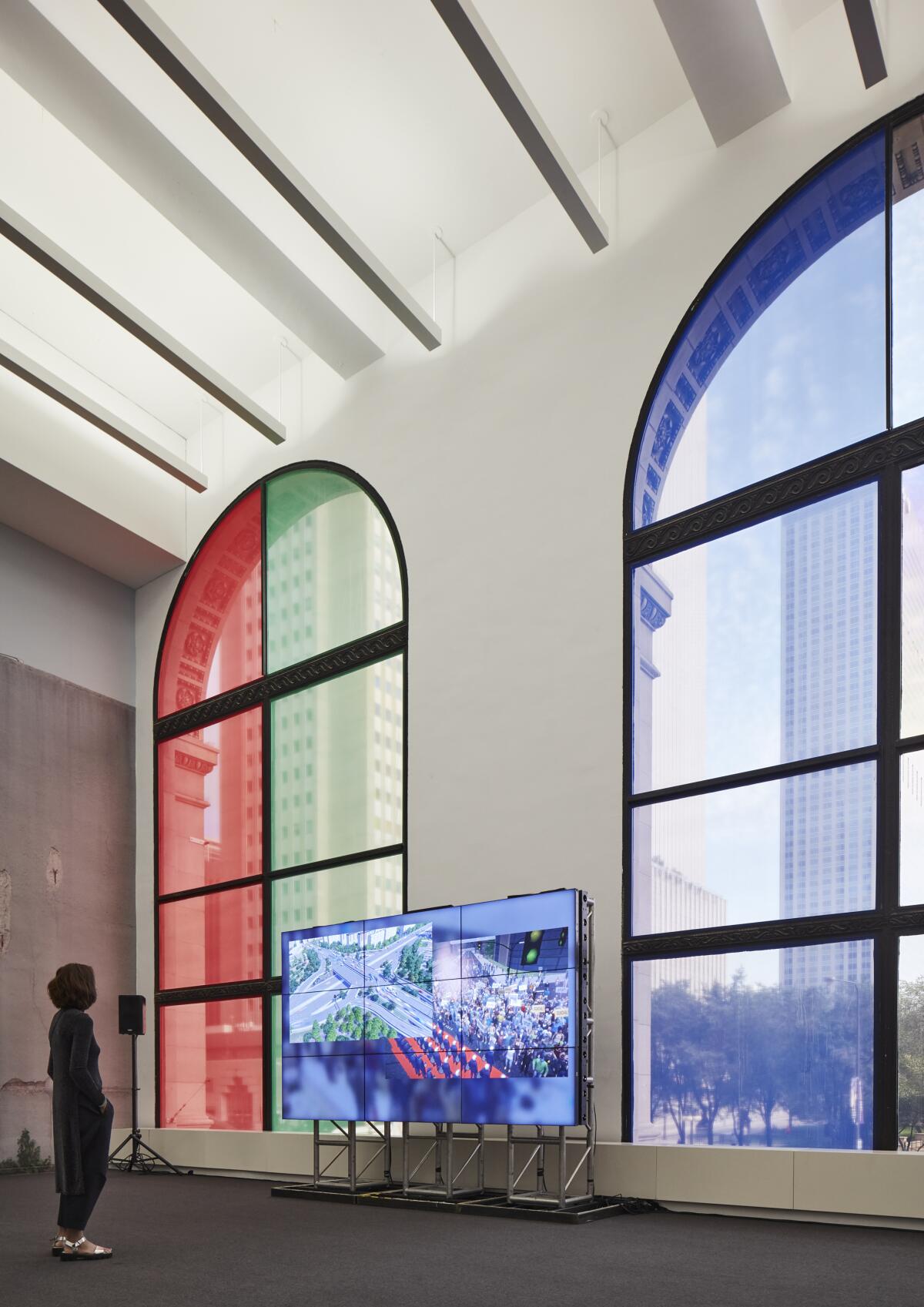Cities around the world are erupting in protest — an architecture biennial examines why

This year’s Chicago Architecture Biennial explores the real-life consequences of urban inequity — such as the explosive protests in Chile and Hong Kong.
Chicago — In September of 1979, the government of Chilean dictator Augusto Pinochet gathered 37,000 people at the National Stadium in Santiago for a ceremony. Like most ceremonies, it was highly choreographed. There was a speech. There was cheering. There were opportunities for the repressive Pinochet to look cuddly as he embraced elderly women before the cameras.
The participants included thousands of pobladores, the inhabitants of the Chilean capital’s myriad informal settlements. And the premise was that the government was giving each of them title to a plot of land they could legally call their own. (“This government isn’t offering anything,” Pinochet declared emphatically. “It is doing everything that others didn’t do.”)
Naturally, there were strings attached.
For one, the land wasn’t given; it was sold. Inhabitants had to show that they had enough savings to purchase their 9x18-meter plot (about 1,700 square feet), then keep up with the payments. Moreover, the plots were located on the periphery of Santiago, which essentially exiled the working poor to the city’s fringes, segregating them from the capital’s political and economic heart, to zones where municipal infrastructure was weak or nonexistent.
These neoliberal policies had the effect of privatizing public lands and leaving critical issues of urban planning and housing in the invisible hands of the market.
Last month, Chileans said they’d pretty much had it with invisible hands. Hundreds of thousands of protesters poured into the streets across the country to protest the stark, economic inequity. (In 2014, the top 10% accounted for almost 58% of the country’s wealth, according to the Organisation for Economic Co-Operation and Development.) The protests have left at least 20 dead and thousands injured. And they continue still.
This turn of events has made an installation at the current Chicago Architecture Biennial eerily prescient.
“The Plot: Miracle and Mirage” is a hypnotic mixed-media installation by Chilean architects Alejandra Celedón and Nicolás Stutzin, made in collaboration with historian and filmmaker Javier Correa.
The piece consists of a large, mirrored box that viewers can step up and look into, like an above-ground pool. But what you see when you peer in isn’t water; it’s a kaleidoscopic video of Santiago’s grid infinitely reflected on the mirrored walls, the public good reduced to an infinite expanse of private, suburban-style plots.
“The city is part of the problem,” says Celedón via email. “It’s territorial segregation has invisibilized our own population.”
Pinochet’s land program, which Celedón also explored in an impactful installation at the Venice Architecture Biennale last year, “transformed the nature of social housing, which, until that moment, was conceived as an inalienable right. It became a consumer good dependent on the savings capacity of potential owners.”
In the video, a cool narrator tells the story of how all of this came to be: “These policies were not envisioned in Santiago but in Chicago.”
She refers to the coterie of Chilean economists who trained at the University of Chicago under Milton Friedman in the 1950s, a group known as the Chicago Boys, who then returned to Chile to implement a range of free-market schemes during the Pinochet regime. Among them, a disastrous privatization of the social security system (which has left some Chilean elderly surviving on less than $200 a month) and housing and land-use policies that are largely shaped by private development — a system that makes little room for the poor. (Santiago, like Los Angeles, is filled with people living in tents.)
“Land was at stake in many of the policies and laws implemented,” says Celedón. “Land management, land property, land use. That was the reason we chose a piece of land — a plot — to tell this story.”
This story, of how unseen economic theories conceived in Chicago gave literal shape to Santiago’s urban plan, and therefore its architecture, is indicative of the broad view taken by the curators of this year’s Chicago Architecture Biennial, titled ”... And Other Such Stories,” and currently on view at the Chicago Culture Center and a handful of off-site locations. It is the third iteration of this rising international architecture show, which this year features work by more than 80 architects, artists, scholars and activist groups, who come from almost two dozen countries.

“This biennial reflects the breadth of what architecture is and what we’ve been trying to do is look at this practice from very different avenues,” says Yesomi Umolu, the show’s artistic director, who oversaw the biennial in collaboration with independent curator Sepake Angiama and Brazilian architect Paulo Tavares. “In the avant-garde of architecture, there have always been these close connections to other endeavors. Architects don’t just produce buildings, they produce books — like Robert Venturi and Denise Scott Brown, who can shift the field with a book.” (She refers to the architect couple’s popular tome, “Learning From Las Vegas.”)
If the previous biennial, organized by the L.A. architects Sharon Johnston and Mark Lee, was an introspective turn that examined architecture’s formal and intellectual roots, this year’s exhibition pulls back, waaaay back.
The show looks at the bigger, often invisible systems — economic policy, development forces, occupation, environment — that give cities their shape. (Those Chicago Boys land-use policies in Chile, for example, gave primacy to the private, single family home.) It also looks at architecture not just as buildings, but as a process that all citizens can engage.
Throughout, issues of equity and inequity loom large.
A room-sized installation by RMA Architects, a studio with offices in India and the U.S., examines unequal access to proper sanitation facilities around the world, with a focus on Mumbai. Another, by Urban Front, an international network of researchers in Europe and the Americas, looks at how public-private partnerships involved in various land use schemes have larded the city of Barcelona with debt.
Other installations highlight the work of activist organizations, such as Brazil’s Movimento Sem Teto do Centro (City Center Homeless People’s Movement), which works to occupy fallow real estate in metropolises such as Sao Paulo to create housing opportunities for the homeless. (Brazil has nearly seven million families that live without adequate housing, yet it is estimated that its cities harbor more than six million vacant properties.)
Collectively, these shine a light on some of the urban conditions that have helped feed discontent and mass protests worldwide. It also has the side effect of highlighting how cities themselves might shape that protest.
The fortified design of Hong Kong Polytechnic University’s campus, for example, which is surrounded by a necklace of ring roads and accessed via limited points of entry, gave anti-government protesters a protected site in which they could barricade themselves. It also served as a trap when police cracked down, leading to daring escapes when protesters threw ropes over the edge of a bridge and shimmied down to waiting motorcycles below.
At the north end of the university’s campus stands a gleaming, futuristic tower designed by the late Pritzker Prize-winner Zaha Hadid. Ironically, the Jockey Club Innovation Tower, completed in 2013, was intended to make the university a “driving force” in transforming Hong Kong into the “design hub” of Asia.
“How can we make spaces more inclusive and equitable?” says Umolu, who also serves as director at the Logan Center for the Arts at the University of Chicago. “And how are people using their voices as a community to press forward? That was important to keep in mind to the biennial — this expansive idea of the field.”
It is indeed an expansive field. In the case of this sprawling biennial, too expansive. Any one of the themes the show tackles — say, environment or land rights or collective action — could have made for its own succinct exhibition. And, as is the case with too many architecture shows, there’s an over-reliance on didactic displays, research projects that have not quite been synthesized into a museum installation.
Some of the galleries are weighed down by walls covered in reams of text, some of which provide all the stimulation of reading a government report. In addition, for a show that purports to be about the invisible political forces that shape our landscape and our architecture, the U.S.-Mexico border region, which has been shaped by forces and policies, seen and unseen, goes unengaged.
None of this means, however, that “...And Other Such Stories” doesn’t contain moments of poetry.
Territorial Agency, an architecture and advocacy organization based in London, created a work titled “The Museum of Oil — The American Rooms,” consisting of a series of behemoth metal panels, installed at vertiginous angles, that occupy the cultural center’s ornate Yates Hall. Etched on these are maps that show the extensive architecture of pipelines and refineries that dominate significant areas of the American landscape.
The installation’s monumentality — the panels feel as if they might crush the viewer — along with the ghostly nature of the etchings, fill the piece with foreboding.
Also remarkable are installations by a pair of L.A.-based artists exploring issues of water: Oscar Tuazon’s wooden “Water School” structures, which are inspired by the self-sufficient, DIY architecture of 1960s, objects that look both ancient and futuristic, as well as Carolina Caycedo’s “The Collapsing of a Model,” an installation whose abstracted swirls reveal landscapes devastated by damn collapses in Colombia and Brazil.
Artist Do Ho Suh, who is based in London, pays tribute to Robin Hood Gardens, the East London housing project designed by Alison and Peter Smithson that was demolished in 2017. In a two-channel video, he shows a seamless scan of the building’s interiors as residents had adapted them over the building’s nearly five decades in existence — a stirring memento mori.
Of particular poignance are four glass-encased structures — each roughly the dimensions of a big shed — that greet visitors to one of the cultural center’s lobby foyers, a collaboration between artist Hank Willis Thomas and MASS Design Group, the nonprofit architectural collective behind the lauded National Memorial for Peace and Justice in Montgomery, Ala.
“The Gun Violence Memorial Project,” as it is titled, is made of the four constructions, each bearing honeycomb walls. Each cell is designed to contain the personal belongings of a gun violence victim: a young man’s Chicago Bulls tank top, a miniature French horn belonging to a teenage musician, a small postcard that welcomed a young girl to her first day of school. That last victim was 5 years old.
“It shows the power of what architecture can do,” says Umolu. MASS Design Group has been very thoughtful in creating “architecture in relation to advocacy,” she adds. “It’s a space of working through trauma. But it’s also a space that is needed — a city dealing with this epidemic — this space of reflection but also of collective action.”
Gun violence shapes a monument. Gun control policy — or lack thereof — shapes our architecture. Designers are now creating schools with mass shootings in mind.
Clara Porset is known for designing a famous Mexican chair. A show at the Art Institute of Chicago looks at how her influence extended far beyond that
The biennial is at its best when it peels back layers, showing the ways in which invisible architectures have shaped our physical ones.
On an upper floor is a video piece by the Berlin-based artist Clemens Von Wedemeyer titled “Transformation Scenario.” It is an uncanny hybrid of footage of real crowds mixed with CGI crowds from Hollywood movies with simulated crowd control scenes drawn from police training software.
It’s a study of human behavior. And it’s a study of the ways in which the architecture of public spaces is designed to control the ways humans move, perhaps by funneling people towards an exit or preventing mass gatherings. (Think: Hong Kong.) It also reveals the situations in which the human is no longer at the center, but becomes technology-adjacent.

“It’s the question of how strongly we are already connected to a parallel world which is somehow invisible,” says Wedemeyer via telephone from Germany. He points to the example of Google Maps — where once we employed paper maps and our own sense of direction, now we rely on an invisible layer of data to direct us from our smartphone.
“It’s this layer upon the real built city,” he says.
One that can be manipulated with the tweak of an algorithm. (Case in point: that time, in 2014, a bunch of residents who live under the Hollywood sign tried to have a route to the sign erased from Google Maps to prevent tourists from transiting through their neighborhood.)
“We are moving through real architecture,” says Von Wedemeyer. “But we are at the same time in a parallel world.”
Like those economic policies of Milton Friedman, they are the architectures we can’t see, but which ultimately control how we live and how we design.
Chicago Architecture Biennial: "...And Other Such Stories"
More to Read
The biggest entertainment stories
Get our big stories about Hollywood, film, television, music, arts, culture and more right in your inbox as soon as they publish.
You may occasionally receive promotional content from the Los Angeles Times.











